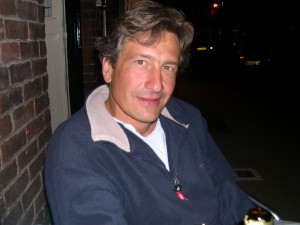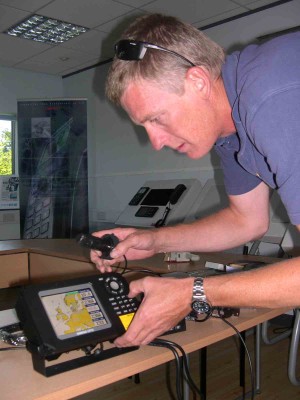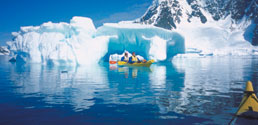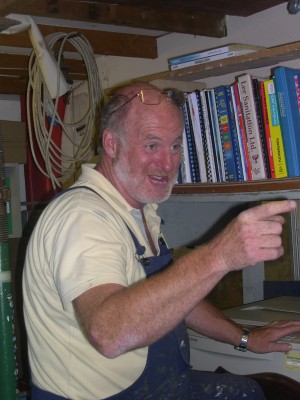
What this guy is about to do makes my Atlantic row look like a pootle across a pond - Adrian Flanagan is going to sail around the world, via the Poles, alone and non-stop. It's never been done before, and nobody knows if it's possible. There's only one way to find out - and that is for Adrian to try it. He's dreamed for 30 years of doing this - it seems to be what he was born to do, so how can he possibly fail?
I was lucky enough to have a drink with him this evening. He'd contacted me via my website, and I'd read his website, so I knew enough about him to be quite intimidated about meeting him. I thought he'd be dauntingly intrepid, focused, a breed apart.
When the doorbell rang I pasted a confident smile on my face and braced myself. There was no need. He was disarmingly charming and normal, with the same hopes, fears and concerns that most people have. He just happens to be about to push back the boundaries of human endeavour, but that doesn't exclude wanting to be a good parent, worrying about money, or being concerned about food, weight and fitness.
I really enjoyed our conversation, and had to keep reminding myself that this man was about to set off into the most hostile environments in the world - a fact of which he is keenly aware.
Wish him luck in his adventure - it will truly be a magnificent achievement, and regardless of whether or not he succeeds, I will be proud to say that I met the man who had this dream and had the courage to go for it.
|
|

Funny how particular names seem to come along in batches - August seems to have brought a rash of Tims, whereas July was dominated by Chrisses. And there was a minor outbreak of Brians earlier in the year. After Tim Gilmore of Dolphin Quay Boatyard, may I now introduce Tim Davies of Simrad marine electronics, seen here bravely attempting to persuade sailing instruments to satisfy a rower's needs - and very nearly succeeding.
I was over at Simrad for several hours this afternoon, making impossible demands of Tim and technology. I wanted the displays to show me wind speed and direction, speed over ground, speed through the water, distance to waypoint, and a stopwatch, all at the same time. Oh, and a stroke meter would be nice too. Surely not so much to ask?!
Tim tolerated my unusual requests with remarkable good humour, and by persuading bits of kit from different families to talk to each other (a feat akin to getting Capulets and Montagues on speaking terms) he managed to give me most of what I wanted.
So now I'll have lots of lovely numbers to contemplate, to while away those long nights at the oars. A bit of star-gazing, a bit of mental arithmetic to work out how many more strokes to Antigua, a bit of music, and of course occasionally remembering to look out for ships - those dark solitary hours will just fly by.
|
|

"We believe in the spirit of adventure - being self-propelled, self-responsible, the need for an unstoppable attitude, the need for challenge. We believe that the world is a better place for those who are prepared to confront the improbable and defy the odds." (mission statement of the Antarctic Peninsula Sea Kayak Expedition)
In January 2001 three men set out to paddle down the length of the Antarctic Peninsula, the point below South America where the Antarctic continent points a finger north. It was to be the southernmost sea kayak journey ever attempted, a 528-mile expedition through the freezing waste of ice, rock, and ocean that makes this one of the most inhospitable coasts on earth.
Their book, The Frozen Coast, describes this ultimately successful journey, undertaken by three New Zealanders: Graham Charles, Mark Jones, and Marcus Waters. Beginning at Hope Bay on the northern tip of the peninsula, they spent the next five weeks battling down this perilous coastline, negotiating huge expanses of broken ice, avoiding collapsing icebergs, dodging the potentially lethal katabatic winds, and constantly struggling with the cold and wet. Eventually the trio succeeded in reaching their goal - the Antarctic Circle at 66 degrees South.
This book has been described as "a gripping account of a great adventure and a fascinating insight into one of the most extreme sea kayak expeditions ever undertaken".
And my Mum gave me a copy of their mission statement, as she thought it summed up perfectly what I am about to do.
|
|

Don't be deceived by the paint-spattered overalls and generally scruffy appearance. This man is a genius. And he's designed what appears to be the best steering system ever to appear on an ocean rowing boat.
Richard Uttley of Dolphin Quay Boatyard worked on the steering system of David Pearse's Petrel, now reincarnated as Ollie Hicks's Miss Olive. He's taken that and improved on it. We now have a heel-steering system that allows me to control the rudder without needing to use my hands, but also avoids the awkward leg positions imposed by toe-steering. And it's low-tech and simple, unlike electronic autohelms.
It looks great on paper. In a few weeks we'll know how it works on the water.
|
|